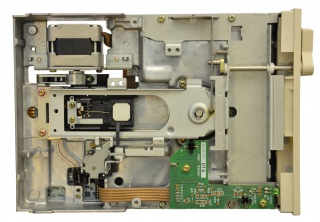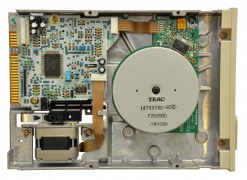Difference between revisions of "Teac FD-55GFR"
Malvineous (Talk | contribs) (Update infobox) |
Malvineous (Talk | contribs) (Add some more background) |
||
| Line 20: | Line 20: | ||
}} | }} | ||
| − | The '''Teac FD-55GFR''' is the most capable drive in the [[Teac FD-55 series]]. | + | The '''Teac FD-55GFR''' is the most capable drive in the [[Teac FD-55 series]], able to read disks written by all other models in the series, and write to many of them as well. It can read and write double-sided high-density 80-track (1.2MB) disks, as well as reading double-sided double-density 40-track (360kB) disks. It is also capable of reading the older single-sided double-density 40-track (160/180kB) format as well, used by the earliest versions of DOS. |
| + | |||
| + | Being an 80-track drive however, it still [[Using 5.25" DD disks in a HD drive|suffers from the same problems]] as any other when writing to 40-track (double-density) disks. | ||
| + | |||
| + | The GFR suffix indicates the drive combines functionality of the G (high-density) and F (double-density) models, with R referring to a refresh, where the design was refined to reduce manufacturing cost and power consumption. | ||
== Additional photos == | == Additional photos == | ||
Revision as of 22:59, 29 February 2016
| Bus type | PC Floppy |
|---|---|
| Bus width | 1-bit |
| Bus speed | 500 kHz 0.5 MHz |
| Manufacturer | Teac |
| Chipset | IR4N171 |
| Compatible with | DOS 1.2MB, DOS 360kB, DOS 180kB |
| Connectors | None |
| Requires -5VDC? | No |
| Requires -12VDC? | No |
| Floppy Drive | |
| Media type | Unknown Property "Has media type" has been marked for restricted use. |
| Sides | 2 |
| Tracks | Unknown "Unknown" is not a number. |
| Density | High |
| Driver | N/A |
The Teac FD-55GFR is the most capable drive in the Teac FD-55 series, able to read disks written by all other models in the series, and write to many of them as well. It can read and write double-sided high-density 80-track (1.2MB) disks, as well as reading double-sided double-density 40-track (360kB) disks. It is also capable of reading the older single-sided double-density 40-track (160/180kB) format as well, used by the earliest versions of DOS.
Being an 80-track drive however, it still suffers from the same problems as any other when writing to 40-track (double-density) disks.
The GFR suffix indicates the drive combines functionality of the G (high-density) and F (double-density) models, with R referring to a refresh, where the design was refined to reduce manufacturing cost and power consumption.

